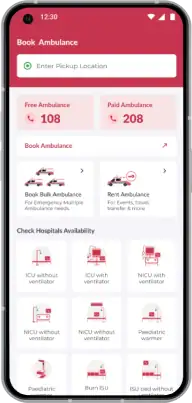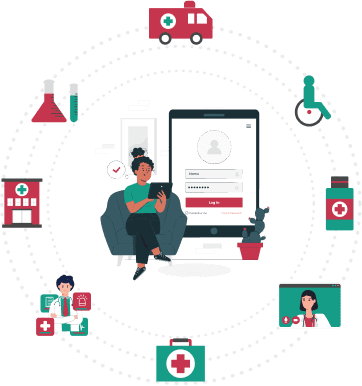Ambulance services have an important role in providing emergency medical assistance and saving lives. With new advancements in technology such as artificial intelligence, the Internet of Things (IoT), and telemedicine, the future of ambulance services looks bright and promising. MedCab ambulance service is part of this revolution. And its app is ready to transform the way we access emergency services. In this blog post, we will explore the current state of ambulance services and how technological advancements can shape the future of ambulance services.
Current State of Ambulance Services
Emergency situations demand swift action and effective patient care. However, many ambulance services are facing several challenges in delivering efficient emergency care these days. This is due to limited resources, communication gaps, and varying response times. To overcome these challenges, a collaboration between ambulance services, hospitals, and relevant stakeholders is needed. By working together and leveraging technology, we can further improve the delivery of efficient emergency care, ultimately saving more lives.
Role of Technology in Transforming Ambulance Services
Advancements in technology like artificial intelligence (AI), machine learning (ML), Internet of Things (IoT), and telemedicine have the power to transform ambulance services.
- AI and machine learning ensure that ambulances are deployed strategically. Together they help in the early detection of medical emergencies for specific patients based on their medical history. This can minimise response times, prevent potential health crises and maximise efficiency.
- Telemedicine platforms also help in saving time in emergency situations by providing virtual consultations and diagnoses. So, the physicians can provide initial treatment guidance and determine the need for ambulance transport.
- Additionally, IoT enables healthcare professionals to continuously monitor patients en route to the hospital, ensuring their stability and enhancing overall patient care. So, they can offer immediate guidance even before the patients reach the hospital.
Potential Benefits of Technological Advancements
The integration of technology in ambulance services offers a multitude of advantages:
Improved Response Times: Real-time traffic monitoring and route optimization can help ambulances reach their destinations faster. Also, the AI-powered decision support systems can help emergency medical specialists in making critical decisions promptly. This reduces delays and enhances response times.
Enhanced Patient Care: Telemedicine enables patients to receive timely medical attention by offering real-time diagnosis. Additionally, seamless transfer of patient data to hospitals ensures that healthcare providers are well-prepared upon the patient's arrival. This facilitates better treatment.
Increased Efficiency and Resource Optimization: AI algorithms can predict emergency service demands and allocate resources accordingly. Furthermore, predictive maintenance of ambulance fleets ensures that vehicles are in optimal condition, which increases overall efficiency and prevents any chance of breakdown.
Challenges and Considerations
Before embracing technological advancements, emergency service providers must prepare for these challenges.
Data Privacy and Security Concerns:
The involvement of technology in ambulance services means handling patients’ sensitive data. To maintain patients' trust and keep these data secure, these services must comply with privacy regulations and implement powerful data privacy measures.
Training and Integration of New Technologies:
For handling new technologies effectively, the proper training of emergency medical personnel is essential. Training programs should be implemented to familiarise the staff with the features and functionalities of the technology, ensuring they can utilise it to its full potential. It is also necessary to keep personnel updated on any advancements or changes.
Equity and Accessibility Issues:
It is important to properly integrate new technologies into existing systems. This ensures the smooth functioning of ambulance services. It may involve careful planning, testing, and collaboration between technology providers and ambulance service providers.
How MedCab App Overcomes These Challenges?
MedCab has recognized the importance of embracing technology to enhance their emergency care service. We understand that leveraging various technological advancements in our ambulance booking app can improve our services.
Here is how we provide an advanced medical emergency service:
1. Advanced Dispatch System: MedCab has implemented an advanced dispatch system that utilises GPS technology and helps in real-time tracking. This allows us to locate the nearest available ambulance to an emergency situation efficiently. Our system also optimises routing by taking into account traffic conditions. This minimises overall response times.
2. Mobile Data Terminals: Each of our ambulances come equipped with mobile data terminals. This provides paramedics with access to vital information and medical records of the patient on the go. It further allows them to make informed decisions and provide appropriate care to patients during transit.
3. Telemedicine Capabilities: MedCab ambulances have integrated telemedicine capabilities. It enables paramedics to connect with medical professionals in real-time and provide required guidance and support. This feature is especially helpful in critical situations and can enhance the quality of care provided to patients.
4. Electronic Health Records (EHR): With electronic health records, MedCab maintains comprehensive and easily accessible patient information. This digital documentation system eliminates the need for paper-based records and ensures that critical patient data is readily available to medical personnel when needed.
5. IoT-enabled Medical Devices: MedCab has incorporated Internet of Things (IoT) technology into their medical devices. This connectivity allows for the automatic transmission of vital signs, such as heart rate, blood pressure, and oxygen levels, to the ambulance staff and receiving hospitals. This real-time data enables prompt decision-making and better continuity of care.
Wrapping It Up
The future of ambulance services is bright with the advancements in technology. MedCab Ambulance service has significantly enhanced its emergency care capabilities by embracing these technological advancements. Evidently, MedCab is ready to create a future where ambulance services provide even faster, more efficient, and life-saving care to those in need.
Download our app or visit our official website to know more about our medical ambulance services.






